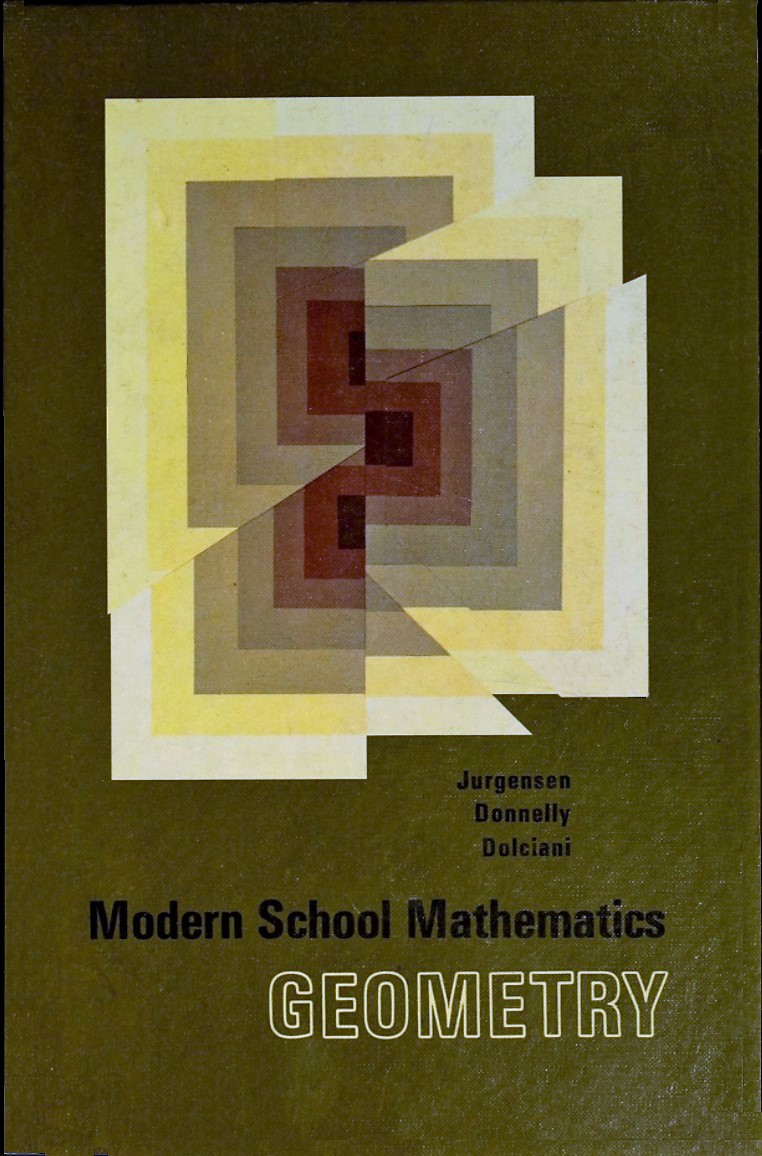These notes are based on a popular 1970s high school geometry book. These notes are provided as supplements to my other geometry notes, such as those for Introduction to Modern Geometry-History/Axiomatic Method/Transformational Geometry (MATH 4157/5157). They are also a bit of a sentimental journey for me, since these notes are based on the book used in my high school geometry class in 1978-79 (thus the groovy images above).
Copies of the classnotes are on the internet in PDF format as given below. The "Proofs of Theorems" files were prepared in Beamer and they contain proofs of the results from the class notes. The "Printout of Proofs" are printable PDF files of the Beamer slides without the pauses. These notes and supplements have not been classroom tested (and so may have some typographical errors).
- Chapter 1. Elements of Geometry.
- Chapter 2. Induction and Deduction.
- Chapter 3. Deduction and Geometry.
- Chapter 4. Angle Relationships: Perpendicular Lines.
- Chapter 5. Parallel Lines and Planes.
- Chapter 6. Congruent Triangles.
- Chapter 7. Applying Congruent Triangles.
- Chapter 8. Similar Polygons.
- Chapter 9. Similar Right Triangles.
- Chapter 10. Circles.
- Chapter 11. Constructions and Loci.
- Chapter 12. Coordinate Geometry-Methods.
- Chapter 13. Coordinate Geometry-Proofs.
- Chapter 14. Transformations.
- Chapter 15. Areas of Polygons and Circles.
- Chapter 16. Areas and Volumes of Solids.
Chapter 1. Elements of Geometry.
- Section 1-1. Representing Sets. Section 1.1 notes
- Section 1-2. Relationships between Sets. Section 1.2 notes
- Section 1-3. Venn Diagrams. Section 1.3 notes
- Section 1-4. Number Lines.
- Section 1-5. Basic Undefined Terms.
- Section 1-6. Some Basic Definitions.
- Section 1-7. Angle.
- Section 1-8. Measure of Angles.
- Section 1-9. Some Special Angles and Angle Relationships.
Chapter 2. Induction and Deduction.
- Section 2-1. Meaning of Induction and Intuition.
- Section 2-2. Perpendicular Lines and Circles.
- Section 2-3. Spheres.
- Section 2-4. Deductive Reasoning.
- Section 2-5. Deduction and Logic.
- Section 2-6. Conditionals.
- Section 2-7. The Law of Detachment.
- Section 2-8. Converses, Inverses, Contrapositives.
Chapter 3. Deduction and Geometry.
- Section 3-1. Postulates and Theorems in Algebra.
- Section 3-2. Geometry as a Mathematical System.
- Section 3-3. Points, Lines, and Planes.
- Section 3-4. Lines and Segments.
- Section 3-5. Two-Column Deductive Proofs.
Chapter 4. Angle Relationships: Perpendicular Lines.
- Section 4-1. Initial Postulates and Theorems.
- Section 4-2. Right Angles and Perpendicular Lines.
- Section 4-3. Supplementary Angles; Complementary Angles; Vertical Angles.
- Section 4-4. The Demonstration of a Theorem.
Chapter 5. Parallel Lines and Planes.
- Section 5-1. Basic Properties.
- Section 5-2. Transversals and Special Angles.
- Section 5-3. Indirect Proof.
- Section 5-4. A Parallel to a Line through an Outside Point.
- Section 5-5. Converses of Earlier Theorems about Parallels.
- Section 5-6. Applying Parallels to Triangles.
- Section 5-7. Applying Parallels to Polygons.
Chapter 6. Congruent Triangles.
- Section 6-1. Congruence of Triangles.
- Section 6-2. Some Ways to Prove Triangles Congruent.
- Section 6-3. More Ways to Prove Triangles Congruent.
- Section 6-4. Overlapping Triangles.
- Section 6-5. Proving Corresponding Parts Congruent.
- Section 6-6. Isosceles Triangles.
Chapter 7. Applying Congruent Triangles.
- Section 7-1. Properties of Parallelegrams.
- Section 7-2. Proving that Quadralaterals Are Parallelograms.
- Section 7-3. Rectangles and Rhombuses.
- Section 7-4. Trapezoids.
- Section 7-5. Inequalities for One Triangle.
- Section 7-6. Inequalities for Two Triangles.
Chapter 8. Similar Polygons.
- Section 8-1. Ratio and Proportion.
- Section 8-2. Properties of Proportions.
- Section 8-3. Similar Polygons.
- Section 8-4. Similar Triangles.
- Section 8-5. Properties of Special Segments in a Triangle.
Chapter 9. Similar Right Triangles.
- Section 9-1. The Altitude to the Hypotenuse of a Right Triangle.
- Section 9-2. The Pythagorean Theorem.
- Section 9-3. Special Right Triangles: 30o-60o-90o and 45o-45o-90o.
- Section 9-4. Right Triangles in Three-Dimensional Figures.
- Section 9-5. Projections into a Plane.
- Section 9-6. The Tangent Ratio.
- Section 9-7. The Sine and Cosine Ratio.
- Section 9-8. Using the Since, Cosine, and Tangent.
Chapter 10. Circles.
- Section 10-1. Tangents.
- Section 10-2. Arcs and Central Angles.
- Section 10-3. Arcs and Chords.
- Section 10-4. Angles Whose Measures Are Half Those of Their Intercepted Arcs.
- Section 10-5. Other Angles Related to Circles.
- Section 10-6. Theorems about Chords, Secant Segments, and Tangent Segments.
Chapter 11. Constructions and Loci.
- Section 11-1. What Construction Means: Permissible Instruments and Basic Angle Constructions.
- Section 11-2. Constructing Parallel Lines and Perpendicular Lines.
- Section 11-3. Constructions Involving Circles.
- Section 11-4. Construcing Special Segments.
- Section 11-5. The Meaning of Locus.
- Section 11-6. Intersections of Loci.
- Section 11-7. Constructions of Loci.
Chapter 12. Coordinate Geometry-Methods.
- Section 12-1. Plotting Points in Two Dimensions.
- Section 12-2. Symmetry.
- Section 12-3. Graphs Meeting Given Conditions.
- Section 12-4. The Distance Formula.
- Section 12-5. The Circle.
- Section 12-6. The Midpoint Formula.
- Section 12-7. The Slope of a Line.
- Section 12-8. Parallel and Perpendicular Lines.
- Section 12-9. Writing Equations of Lines.
- Section 12-10. Additional Properties of Lines.
Chapter 13. Coordinate Geometry-Proofs.
- Section 13-1. Placing Coordinate Axes.
- Section 13-2. Parallel and Perpendicular Lines.
- Section 13-3. Distances.
- Section 13-4. Triangles.
- Section 13-5. Parallelograms.
- Section 13-6. Trapezoids and General Quadrilaterals.
Chapter 14. Transformations.
- Section 14-1. Mappings and Transformations.
- Section 14-2. Stretching and Shrinkings: Expansions and Contractions.
- Section 14-3. Translations.
- Section 14-4. Reflections.
- Section 14-5. Products of Transformations.
Chapter 15. Areas of Polygons and Circles.
- Section 15-1. What Area Means: Basic Definitions and Postulates.
- Section 15-2. Areas of Rectangles and Parallelograms.
- Section 15-3. Areas of Triangles and Trapezoids.
- Section 15-4. Comparing Areas of Similar Triangles.
- Section 15-5. Special Properties of a Regular Polygon.
- Section 15-6. Areas of Regular Polygons.
- Section 15-7. Comparing Areas of Similar Polygons.
- Section 15-8. The Circle as a Limiting Case of an Inscribed Regular Polygon.
- Section 15-9. Area of a Circle.
- Section 15-10. Arcs, Sectors and Segments.
Chapter 16. Areas and Volumes of Solids.
- Section 16-1. Vocabulary for Prisms and Pyramids.
- Section 16-2. Areas and Volume of a Prism.
- Section 16-3. Area and Volume of a Pyramid.
- Section 16-4. Area and Volume of a Right Circular Cylinder.
- Section 16-5. Area and Volume of a Right Circular Cone.
- Section 16-6. Volume and Surface Area of a Sphere.
- Section 16-7. Areas of Similar Solids.
- Section 16-8. Volumes of Similar Solids.
Return to Bob Gardner's home page





